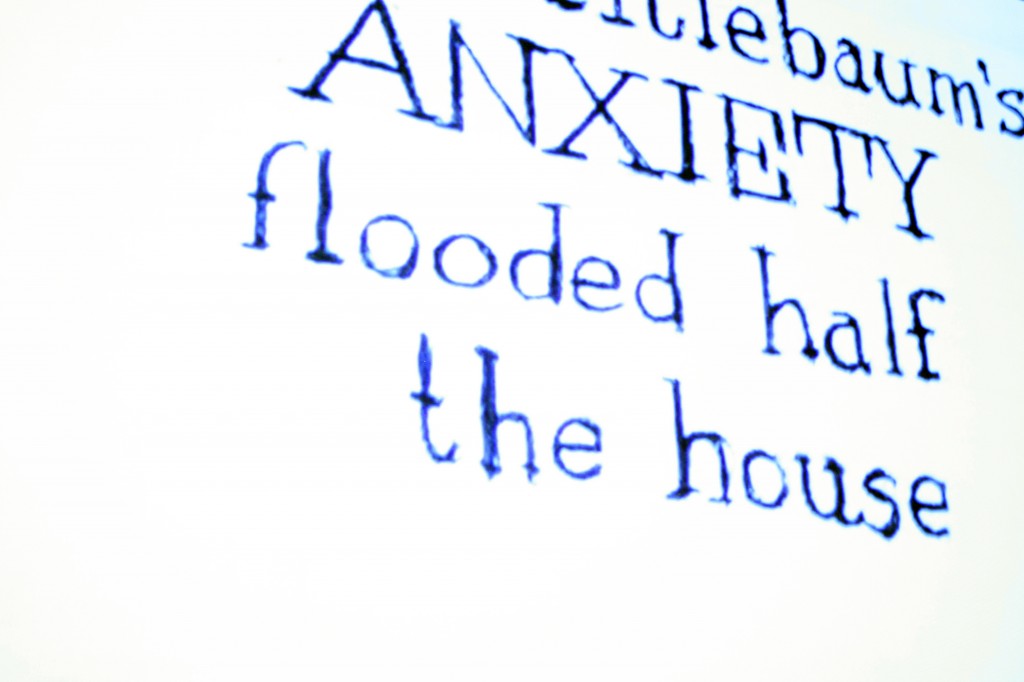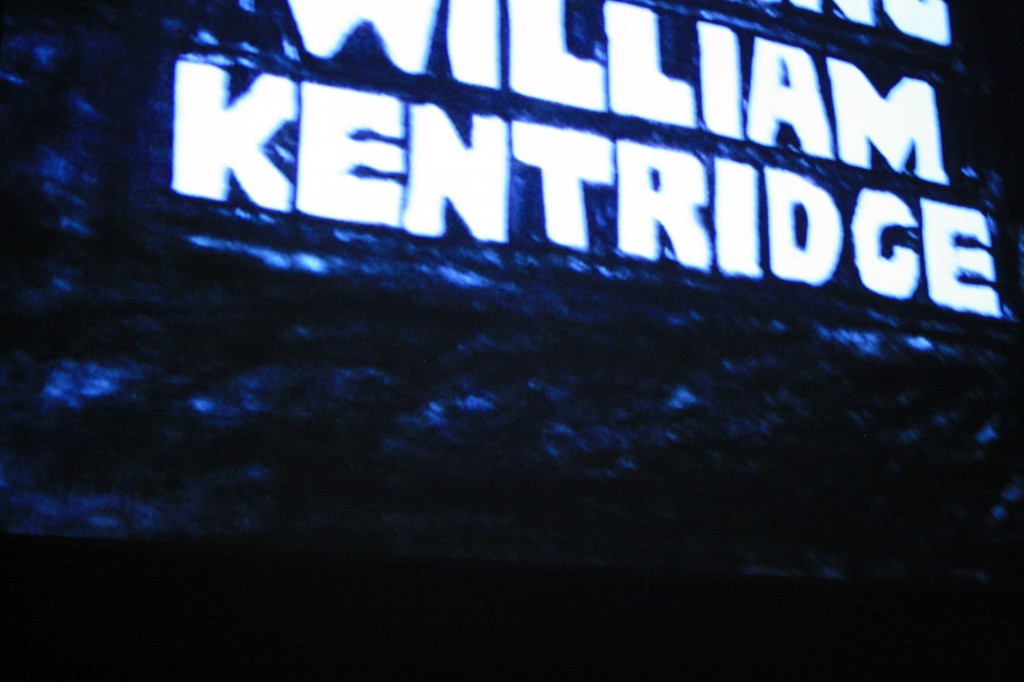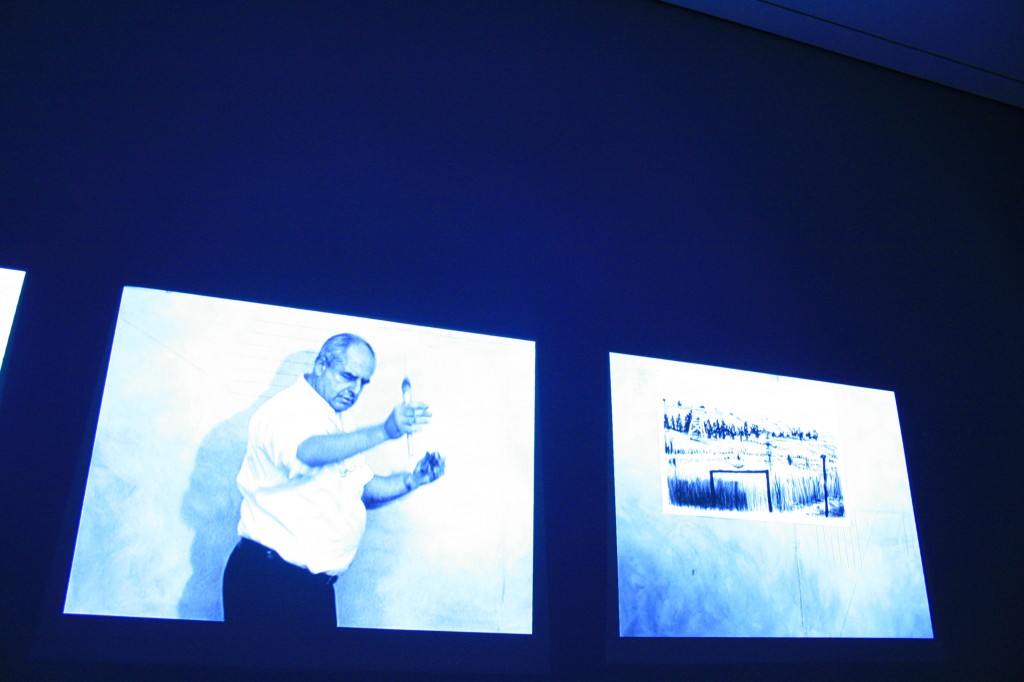
Snap shot of the exhibition, "William Kentridge: Five Themes," now on view at the Museum of Modern Art, NY
The best word to describe my undergraduate experience as a Drawing/Painting major is miseducation — to educate improperly — though what I learned as an artist in school is quite invaluable. There wasn’t as much instruction as there were socialization tactics. I supplemented my studies with unintended diversions to the oftentimes absurd, as one could describe a painting studio. Luckily, the school I faltered into had studio professors that grew to mean something to me. Sitting here now looking back, the one aspect that impresses me most is how they weeded students out. They would tell you everyday how thankless being an artist was and how you will make no money. Vernon Fisher once told me that I would have a better time doodling between customers as a cashier at the local 7/11 for the rest of my life. He said that artists simply do not make a living unless they put up a huge fight; in fighting you train, and in fighting there is either success, or defeat. I was successfully socialized into thinking that the function of art goes beyond personal comfort.
In 2002, a friend convinced me to skip class to drive down to Houston, Texas, in her ‘97 Ford Mustang to see the William Kentridge exhibition at the Contemporary Arts Museum (CAMH). A six-hour car ride later, I was submissively thrilled to enter into a space adorned by oversized, dark charcoal drawings on paper of street lamps, rotary telephones, and other quotidian still-life subjects. There was an economy to his work that struck me immediately. It was something that I paid close attention to, as I had not yet seen a contemporary artist use drawing/painting in the manner of the everyday. On our campus, there were many popular drawing/painting icons that influenced us fledglings, artists like Gerhard Richter, Sigmar Polke, Richard Prince, and David Salle. When I skipped class to see these works, they seemed triumphant or to have large production budgets. That was honestly the first thing that impressed me when I entered into museum spaces; secondly, I was naturally impressed by the artists’ abilities to use material as their signature. One not only recognizes these artists’ own artwork; they recognize when someone else borrows their technique.
Economy, for me, doesn’t only apply to material and budget; rather it implies more conceptual means. I am hesitant to say your material defines your political proclivities, but I believe it is all intrinsically linked. A very popular quote by Kentridge that I pulled from the book, William Kentridge: Drawings for Projection, in an essay by Neal Benezra, explains this sentiment well:
“Drawing for me is about fluidity. There may be a vague sense of what you’re going to draw, but things occur during the process that may modify, consolidate, or shed doubts on what you do know. So drawing is a testing of ideas; a slow-motion version of thought….The uncertain and imprecise way of constructing a drawing is sometimes a model of how to construct meaning. Out of the process of drawing comes both the content of the work and, implicitly, an analogue for life itself. I believe that in the indeterminacy of drawing, the contingent way that images arrive in the work, lies some kind of model of how we live our lives. The activity of drawing is a way of trying to understand who we are or how we operate in the world. It is in the strangeness of the activity itself that can be detected judgment, ethics, and morality.”
In Benezra’s essay, he mentions that Kentridge suggested at one point that Western European and North American art was too apolitical and self indulgent. And maybe I felt, as an undergrad student in Denton, Texas, that there was no place for my historic and aesthetic background within this canon as well…unless you were Shahzia Sikander. Living a life of double perspective, or dual identity, hooked me into Kentridge’s work early in my studies. The symbolism in his simple and effortless-seeming practice both supports and encourages the lifestyle of making, because you believe what you make signifies life.
In my memory of the exhibition in 2002, I happened upon a drawing and on the other side of the wall on which it hung, I heard children shuffling and futzing with their trinkets and sheer joy for life, as a man instructs them on what they saw. Envy ran through my veins — how could this group of kids be any more lucky than this? They get to visit an incredible exhibition in a beautiful museum. When I was their age, our school’s art field trips consisted of repetitive visits to the Omni Theater in Fort Worth, Texas, where I saw the The Alamo more than twice. I walked around the corner to join the group where, laughingly, the docent, my friend, and I all towered over the very short group of people. The docent impressed me — he was enigmatic and looked just like the characters in the animations on view. Hmmm. Utter envy! These kids were getting a personal tour of the exhibition led by William Kentridge.
Kentridge very professionally ended the tour by opening it up to his guests. I patiently waited for any responses and then mustered up the confidence to ask the quintessential how do you make art? question. How do you make work that means more than following techniques and trends? How do you express yourself and remain sincere within a culture that indemnifies that act?
Kentridge gave me the advice of a lifetime, reminding me first that the life of an artist is romanticized in our society. One considers exhibiting art as masterpiece and this is unhealthy, as art does not come from a sudden premonition or epiphany. He told me to look around and see the evidence of his everyday; he told me daily practice and discipline brings you to artmaking. Out of the act of drawing, no matter how terrible, your ideas emerge.
If you are not already overly saturated by this man’s prolific and widely-received presence, check out the Museum of Modern Art, NY exhibition, now on view until May 17, 2010.






Pingback: What’s Cookin’ at the Art21 Blog — A Weekly Index | Art21 Blog